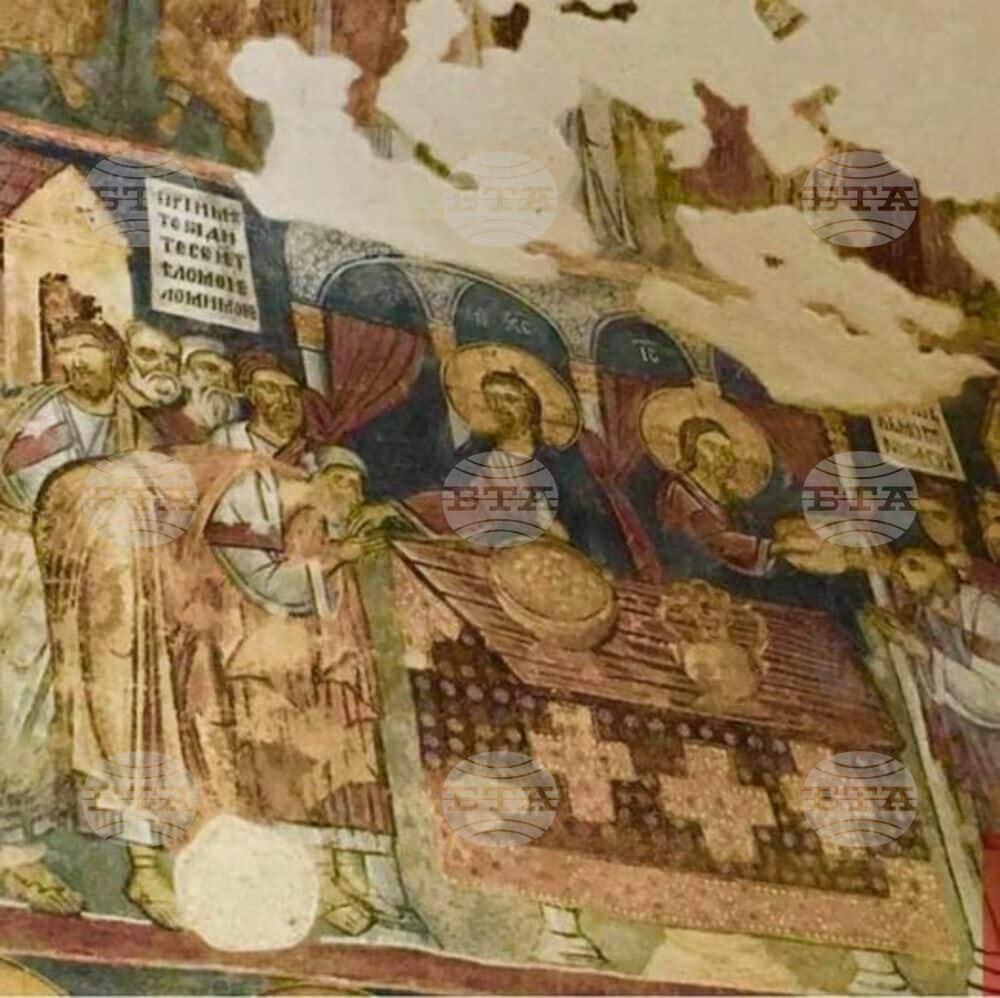The unknown predecessor of Leonardo da Vinci from our lands saw the biblical plot “The Last Supper” in a different way, which makes the temple extremely valuable for world culture
The only fresco of its kind, depicting the forging of the nails for the Crucifixion, can be seen in the Zemen Monastery (painted in the 14th century), reports the Regional Administration – Pernik, quoted by BTA.
The church is the only cross-domed temple in Bulgaria with a cubic shape – 9 by 9 by 9 meters. When entering from the vestibule to the altar, an inscribed cross in a square is formed. The dome of the church is also an inscribed square. The frescoes date from the 14th century, although earlier iconography is not excluded. “St. John the Theologian” is also unique with the only wall painting in our country – the forging of the nails for the cross of Christ. This fresco is nowhere to be found in temples and monumental painting, neither in the East nor in the West.
The frescoes in the monastery church “St. John the Theologian” tell about the way of Jesus to Calvary. The unknown predecessor of Leonardo da Vinci from our lands saw the biblical plot “The Last Supper” in a special way.
On it, Christ is depicted twice, with two images – one Christ hands the bread, the other pours the wine. The “Double Christ” cannot be seen anywhere else. This different reading makes the temple extremely valuable for world culture.
One can talk for a long time about the interesting interpretations of the famous biblical scenes in the frescoes of the monastery, about a number of unique motifs from the life and being of people, about the authenticity and development of faith, but it is better to see them live. Today the complex includes two buildings, a bell tower and a church. On its territory there are centuries-old trees with beautiful trunks and huge crowns. The sense of calm and peace with yourself and the world here is remarkable. The Zemensky monastery is not inhabited by monks and has been turned into a museum. On March 5, 1966 The Zemen church has been declared a monument of Bulgarian architecture and painting, and the Zemen monastery – a national museum, which since 2004 has been a branch of the National History Museum. It has been declared a monument under the protection of UNESCO.
At the foot of the north-eastern slope of Risha Mountain, on a beautiful terrace, a unique pearl is nestled – one of the most valuable monuments of the Middle Ages – the Zemensky Monastery “St. John the Theologian”. The crystalline waters of a large spring bubble up next to the monastery. Located only about 80 km. from the city of Sofia, near the city of Zemen at the foot of the Konyavska mountain, the Zemen monastery enchants with its timelessness and beauty. It is not as big and as famous as the Rila Monastery or the Bachkovo Monastery, but just like them, it hides unsuspected secrets and treasures within itself. It has magic, history, faith. On August 9, 1909 Zemen railway station is solemnly opened. Many people from the capital and cultural figures visit Zemensko and discover the uniqueness of the Zemensko monastery, its wonderful wall paintings, the work of an unknown local artist from the Middle Ages.
Prof. Yordan Ivanov made the first publication about the Earthly Church, with which he announced to the country and the world about the existence of a hitherto unknown and valuable historical monument from the 14th century. The Zemenska Church rivals in value the Boyana Church in Sofia, built in 1259. In-depth studies prove that the church in Zemen dates back not to the XIV, but to the XI century. It was repeatedly burned. The phenomenal thing is that the monastery fence, the monastery building was demolished and rebuilt many times, but the church with the frescoes was not destroyed and survived for more than 7 centuries. From the studies of the monastery archives, it is clear that the church was strengthened in 1830 and 1860. A major architectural restoration of the church was carried out in 1968. Complete conservation of the frescoes was carried out in 1970-1974. under the leadership of Bonka Ilieva. During the conservation, it was discovered that under the frescoes from the 14th century there is an older layer of frescoes, which refers to the monumental art of the 12th-13th centuries. The frescoes from the first painting layer belong to the second half of the 11th century. The popularity of the monument is due not only to the interesting architectural solution, but also to the remarkable wall paintings with biblical scenes. The altar is made of a stone monolith, and the floor is made of multi-colored stone slabs and antique bricks. The Zemlenska church is also another proof that the Zemlengrad fortress existed on these lands at the beginning of the 13th century, and it was rich and significant for its time. The founders of the church were the Earthly ruler Despot Deyan and his wife Doya. Their portraits decorate the walls of the monastery and are one of the earliest portraits of Bulgarian boyars and of the greatest artistic value, like the images of Sevastokrator Kaloyan and Desislava from the Boyana church.
The frescoes of the church are painted with great skill and elegance. The paints with which the earthly artist used to keep the murals so vivid and colorful for so many centuries remain a mystery. From the first mural layer, the most preserved is the depiction of “Rejecting the Gifts of Joachim and Anna”. The painting is divided into four zones. To the right of the entrance are the inscribed portraits of the founders of Despod Deyan and Doya and their family. They are unique, because only in the Boyan Church and in the Zemen Monastery in the times of Medieval Scholasticism were living people drawn, and not only saints and icons. It was revolutionary for its time and heralded the Renaissance. Their images are a valuable source for the clothes and ornaments of the boyars from the beginning of the 14th century. The most impressive is the image of Doya – a young woman, with beautiful expressive eyes, dressed in a red tunic with long lace sleeves, with a white veil on her head and a crown. Above the heads is the founder’s inscription “This temple was written, dedicated to St. John the Theologian with the favor of Despod Deyan. All inscriptions in the church are in Old Bulgarian literary language.
Illustration: The unique fresco depicting the forging of the nails for the Crucifixion, with the “Double Christ”, preserved in the Zemen Monastery (Photo: Regional Administration – Pernik) / BTA














 English
English French
French Spanish
Spanish German
German Dutch
Dutch Italian
Italian Danish
Danish Portuguese
Portuguese Greek
Greek Russian
Russian Swedish
Swedish Bulgarian
Bulgarian Hungarian
Hungarian Catalan
Catalan Ukrainian
Ukrainian Polish
Polish Basque
Basque Chinese (Simplified)
Chinese (Simplified) Japanese
Japanese Hebrew
Hebrew Arabic
Arabic Swahili
Swahili Amharic
Amharic Irish
Irish Afrikaans
Afrikaans Albanian
Albanian Armenian
Armenian Azerbaijani
Azerbaijani Belarusian
Belarusian Bengali
Bengali Bosnian
Bosnian Cebuano
Cebuano Chichewa
Chichewa Chinese (Traditional)
Chinese (Traditional) Corsican
Corsican Croatian
Croatian Czech
Czech Esperanto
Esperanto Estonian
Estonian Filipino
Filipino Finnish
Finnish Frisian
Frisian Galician
Galician Georgian
Georgian Gujarati
Gujarati Haitian Creole
Haitian Creole Hausa
Hausa Hawaiian
Hawaiian Hindi
Hindi Hmong
Hmong Icelandic
Icelandic Igbo
Igbo Indonesian
Indonesian Javanese
Javanese Kannada
Kannada Kazakh
Kazakh Khmer
Khmer Korean
Korean Kurdish (Kurmanji)
Kurdish (Kurmanji) Kyrgyz
Kyrgyz Lao
Lao Latin
Latin Latvian
Latvian Lithuanian
Lithuanian Luxembourgish
Luxembourgish Macedonian
Macedonian Malagasy
Malagasy Malay
Malay Malayalam
Malayalam Maltese
Maltese Maori
Maori Marathi
Marathi Mongolian
Mongolian Myanmar (Burmese)
Myanmar (Burmese) Nepali
Nepali Norwegian
Norwegian Pashto
Pashto Persian
Persian Punjabi
Punjabi Romanian
Romanian Samoan
Samoan Scottish Gaelic
Scottish Gaelic Serbian
Serbian Sesotho
Sesotho Shona
Shona Sindhi
Sindhi Sinhala
Sinhala Slovak
Slovak Slovenian
Slovenian Somali
Somali Sundanese
Sundanese Tajik
Tajik Tamil
Tamil Telugu
Telugu Thai
Thai Turkish
Turkish Urdu
Urdu Uzbek
Uzbek Vietnamese
Vietnamese Welsh
Welsh Xhosa
Xhosa Yiddish
Yiddish Yoruba
Yoruba Zulu
Zulu